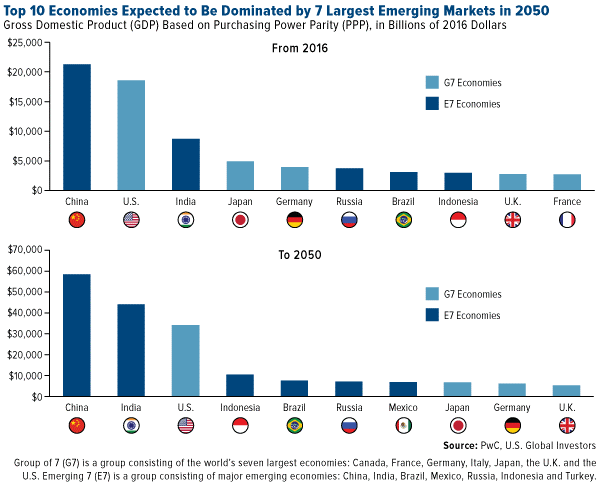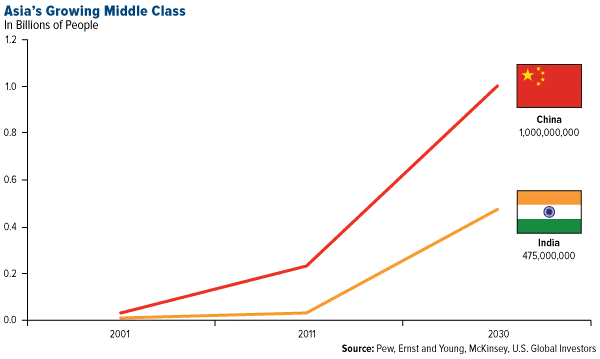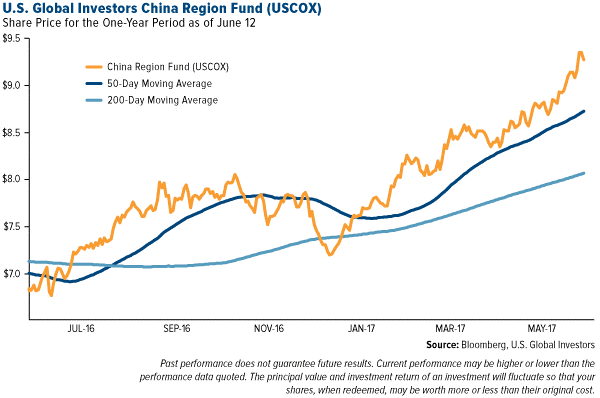One Easy Way to Invest in the “Asian Century”

The 19th century belonged to the United Kingdom, the 20th century to the United States. Many market experts and analysts now speculate that the 21st century will be remembered as the “Asian Century,” dominated by rising superpowers such as Indonesia, India and China.
It’s those last two countries, India and China—home to nearly 40 percent of the world’s population—that I want to focus on. Both emerging markets offer attractive investment opportunities, especially for growth investors who seek to derisk from American equities.
Look at how dramatically the two have expanded in the last half century. As recently as 1970, neither country controlled a significant share of world gross domestic product (GDP). As of June of this year, however, China represents more than 15 percent of world GDP, India more than 3 percent. This has displaced Russia and Spain, itself the world’s wealthiest economy in the 16th century.

And the expansion is expected to continue. Back in February, I shared with you research from PricewaterhouseCoopers (PwC), which predicts that by 2050, China and India will become the world’s number one and number two largest economies based on purchasing power parity (PPP). (PPP, if you’re unfamiliar, is a theory that states that exchange rates between two nations are equal when price levels of a fixed basket of goods and services are the same.)

Also note Indonesia, which is expected to replace Japan as the fourth-largest economy by midcentury.
A Surge In Middle Class Spenders
What should excite investors the most is the growing size of the middle class in China and India. More middle class consumers means more spending on goods and services and more investing.
Remember, China’s middle class is already larger than that found here in the U.S., according to Credit Suisse. In October 2015, the investment bank reported that, for the first time, the size of China’s middle class had exceeded that of America’s middle class, 109 million to 92 million. As incomes rise, so too does demand for durables, luxury goods, vehicles, air travel, energy and more.

Living standards have risen dramatically in China. According to Dr. Ira Kalish, a specialist in global economic issues for Deloitte, hourly wages for manufacturing jobs in China are now higher than those found in Latin American countries except for Chile. They’re even nearing wages found in lower-income European countries such as Greece and Portugal.
Looking ahead to 2030, China is expected to have a mind-boggling 1 billion people—more than three times the current U.S. population—enjoying a middle class lifestyle filled with middle class things, from cars to designer clothes to electronics and appliances.

India, meanwhile, will have an estimated 475 million people among its middle class ranks. The South Asian country is currently the fastest-growing G20 economy, with Morgan Stanley analysts estimating year-over-year growth to hit 7.9 percent in December. Driving this growth is a steady increase in wages and pensions, which will support consumption of goods and services.
Demographic trends in India make the country look especially favorable. As I’ve shared with you before, India has a young population, with an average age of 29. (The average age in China, by comparison, is around 37, while Japan’s is 48.) By 2020, more than 64 percent of Indians will be under the age of 35. For many years to come, therefore, India will have a much larger group of working-age individuals than any other country on earth.
In fact, India’s total population could now be larger than China’s, according to new estimates. Yi Fuxian, a researcher at the University of Wisconsin-Madison, believes China’s population is much smaller than official statistics, owing to years of slower population growth under the one-child policy. Yi insists that about 90 million fewer people reside in China than previously thought, meaning its 2017 population could be closer to 1.29 billion people. That would narrowly make India, home to 1.31 billion people, the world’s most populous country.
Investing In 40 Percent Of Humanity
So how can investors take advantage of this rapid growth in spending power?
One of the best ways, I believe, is with our China Region Fund (USCOX), which invests in securities in the authorized China securities markets (Hong Kong, Shenzhen and Shanghai) as well as the surrounding countries, including India.
The fund, which seeks to achieve long-term capital appreciation, focuses on companies that we believe are poised to benefit the most from an increase in middle class consumption. That includes automotive firms (Geely Automotive, Great Wall Motor), pharmaceuticals (CSPC Pharmaceutical, Sinopharm), information technology (Tencent, NetEase), consumer discretionary (Anta Sports) and much more.
For the one-year period as of June 12, USCOX was up more than 35 percent, well ahead of its 50-day and 200-day moving averages.

Click here to see the fund’s performance.
To learn more about investment opportunities in the “Asian Century,” visit the USCOX fund page!
Please consider carefully a fund’s investment objectives, risks, charges and expenses. For this and other important information, obtain a fund prospectus by visiting www.usfunds.com or by calling 1-800-US-FUNDS (1-800-873-8637). Read it carefully before investing. Foreside Fund Services, LLC, Distributor. U.S. Global Investors is the investment adviser.
Foreign and emerging market investing involves special risks such as currency fluctuation and less public disclosure, as well as economic and political risk. By investing in a specific geographic region, a regional fund’s returns and share price may be more volatile than those of a less concentrated portfolio.
Fund portfolios are actively managed, and holdings may change daily. Holdings are reported as of the most recent quarter-end. Holdings in the China Region Fund as a percentage of net assets as of 3/31/2017: Geely Automobile Holdings Ltd. 7.00%, Great Wall Motor Co. Ltd. 0.54%, CSPC Pharmaceutical Group Ltd. 3.48%, Sinopharm Group Co. Ltd. 1.84%, Tencent Holdings Ltd. 5.47%, NetEase Inc. 0.75%, ANTA Sports Products Ltd. 2.36%.
All opinions expressed and data provided are subject to change without notice. Some of these opinions may not be appropriate to every investor.
********







 Frank Holmes is the CEO and Chief Investment Officer of
Frank Holmes is the CEO and Chief Investment Officer of 










